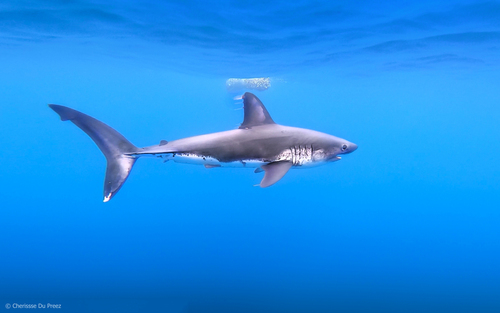
Salmon Shark
The Atlantic Bluefin Tuna (Thunnus thynnus) is a highly migratory, large pelagic fish known for its incredible speed, size, and commercial value. Revered in culinary circles and a target of intense fishing pressure, this species plays a crucial role in marine ecosystems.
20 25 years
Lifespan
200 - 300 cm
Length
Least Concern
Conservation Status
50 km/h
Swimming speed
Carnivorous
Diet
Highly Migratory, Seasonal Migration
Migration
Appearance Overview
The Atlantic Bluefin Tuna is renowned for its large, streamlined body, built for speed and endurance.
Color
Dark metallic blue on top with a silvery underside
Body Shape
Torpedo-shaped, designed for efficient movement through water
Fins
Two dorsal fins, the first retractable; small, yellow finlets run down the back and belly to the tail
Length
Up to 10 feet (3 meters), commonly around 6.5 feet (2 meters)
Weight
Up to 1,500 lbs (680 kg), commonly around 550 lbs (250 kg)
Diet
Carnivorous, feeding on a variety of fish, squid, crustaceans, and occasionally, zooplankton and eels.
Feeding Behavior
Highly active predator that uses its speed and agility to hunt; often feeds cooperatively, herding and corralling prey.
Social Behavior
Forms schools, sometimes segregated by size; highly migratory, capable of crossing entire oceans.
Commercial Relevance
Extremely high value, especially in sushi and sashimi markets, where a single fish can be sold for thousands of dollars.
Conservation measures
Subject to international fishing quotas, catch limits, and monitoring programs; efforts to establish marine protected areas.
Status
Endangered
Threats
Overfishing, illegal and unregulated fishing, habitat degradation, and climate change impacts on prey availability.
Habitat Distribution
Depth Range
Surface to 900 meters, though they are often found in shallower waters
Geographic Range
Atlantic Ocean, from Newfoundland to the Gulf of Mexico, and from the Canary Islands to the Mediterranean Sea
Preferred Environment
Primarily pelagic, inhabiting both cold temperate and warm tropical waters
Reproduction and Life Cycle
Breeding Habits
Spawns in warm waters, with two main spawning grounds: the Mediterranean Sea and the Gulf of Mexico; breeding season varies by location.
Development Stages
Eggs hatch into larvae that feed on plankton; juveniles grow rapidly, transitioning to a diet of fish and invertebrates as they mature.
Fecundity
Females can release up to 30 million eggs per season, with spawning occurring in batches.
Maturity Age
Reaches sexual maturity at approximately 4-8 years, depending on the population and environmental conditions.
Faqs about Salmon Shark
Where can Atlantic Bluefin Tuna be found?
Atlantic Bluefin Tuna are primarily found in the Atlantic Ocean, ranging from the cold waters of the North Atlantic to the warmer tropical waters.
Do Atlantic Bluefin Tuna migrate?
Yes, they are highly migratory fish, known for their long-distance migrations across the Atlantic Ocean for feeding and spawning.
What do Atlantic Bluefin Tuna eat?
Atlantic Bluefin Tuna are carnivores, feeding on a variety of fish, squid, and crustaceans.
How big can Atlantic Bluefin Tuna get?
They can grow up to 10 feet (3 meters) in length and weigh up to 1,500 lbs (680 kg).
What is the conservation status of Atlantic Bluefin Tuna?
They are classified as Endangered due to overfishing and other threats.
When do Atlantic Bluefin Tuna reach maturity?
They reach sexual maturity at around 4-8 years of age.
How many eggs can a female Bluefin Tuna lay?
Females can produce millions of eggs per spawning season, contributing to their high reproductive potential.
What are some distinctive features of Atlantic Bluefin Tuna?
Atlantic Bluefin Tuna are known for their torpedo-shaped bodies, dark metallic blue coloration on top, and silvery undersides.
What are the main threats to Atlantic Bluefin Tuna?
Besides overfishing, they face threats from habitat degradation and climate change, affecting their prey and migration patterns.
What conservation measures are in place for Atlantic Bluefin Tuna?
Conservation efforts include strict fishing quotas, monitoring of populations, and the establishment of marine protected areas.
Copyright @ Nature Style Limited. All Rights Reserved.
 English
English